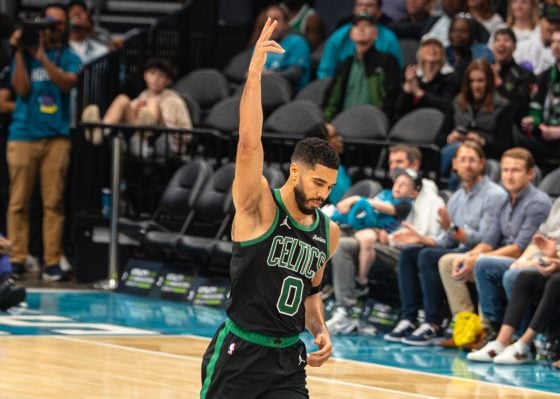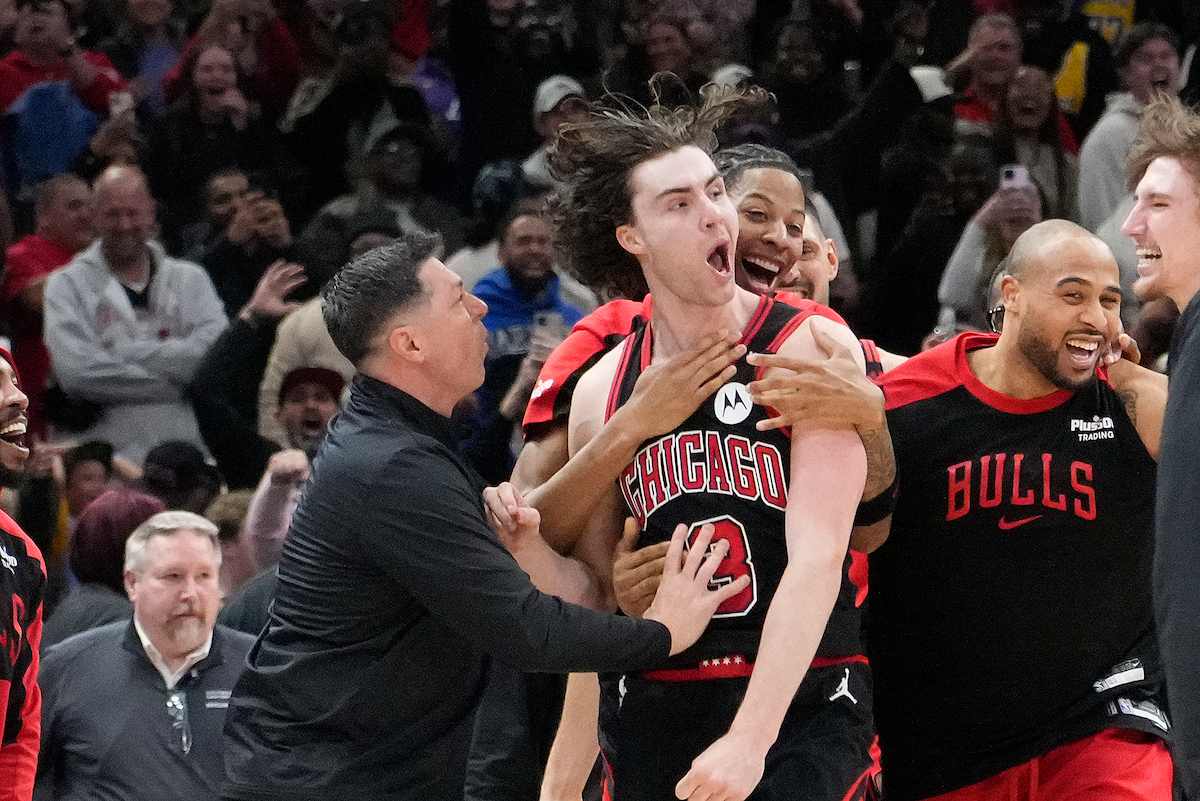The NBA’s All-Star break has come and gone, and as the dust settles on another bizarre and idiosyncratic weekend of festivities, the Boston Celtics return to the court tonight. They’ll kick off their stretch run on TNT against the Philadelphia 76ers, and as we prepare for the last two-ish months of regular season basketball, it feels like a good opportunity to look back to last season’s team at the same benchmark. How do these Celtics compare to their championship selves from last year?
Photo By Winslow Townson/Getty Images
Let’s get the simplest fact out of the way first: the Celtics return to play with a record of 39-16, a mark that falls short of the 43-12 they posted heading into the break last season. The four-game difference in the win column doesn’t fully illustrate the contrast in how this team feels to many, relative to last year. We’ve seen them struggle for a notable chunk of the year, which is something that just did not happen last season.
Late December into January is obviously where the separation point takes shape. The Celtics lost three out of four games starting on December 19 against Chicago — including their first consecutive losses of the season — and suffered seven more losses from that point through the end of January. Within that span of time, their longest win streak was just three games. They just could not develop any consistency, winning 30+ point blowouts one night and dropping disappointing losses the next.
This is the kind of stretch that last season’s championship team simply never had. Consistency was the superpower of the 2023-24 Celtics. They did not lose consecutive games for the first time last season until March 7, a remarkable feat that helped them carry the top spot in the Eastern Conference wire-to-wire to such an extent that it was never in any serious doubt. This is perhaps the biggest reason why this year’s team is perceived as being a step or two behind. They made it all look impossibly easy.
:no_upscale()/cdn.vox-cdn.com/uploads/chorus_asset/file/25880104/2157528659.jpg)
Photo by Jesse D. Garrabrant/NBAE via Getty Images
Interestingly enough, the championship team’s biggest “slump,” relatively speaking, took place in the same time span as this team’s. After opening the season a ludicrous 26-6 through the end of 2023, the Celtics matched that loss total over the next 23 games, going 17-6 heading into All-Star Weekend. It’s a joke to suggest a win percentage of nearly 74% qualifies as a slump, but it’s not much more of one than what the Celtics actually did to the Eastern Conference last year.
Peripheral numbers similar suggest a slight step back for this year’s version of the roster, but not much of one. They’ve recorded a net rating of +9.2 per NBA Stats, which is a decline from last year’s +10.3. As much as they’ve sank back, though, the rest of the NBA has more significantly surged ahead. That +9.2 mark would have still comfortably led basketball last season; the Oklahoma City Thunder were a distant second place at +7.3. This year, it ranks third — the Thunder lead the pack with a ridiculous +12.8, and the Cleveland Cavaliers hold second place at +10.4. The Celtics’ competition has risen to their championship level more than they themselves have lagged behind it.
One notable shift has been the Celtics’ increased reliance on the three-pointer. Already the league’s most prolific team from deep, Joe Mazzulla has them letting it fly even more frequently this season. Three-pointers accounted for 47% of Boston’s shots as of the All-Star break last season; this year, that’s risen to 53%. This is a comically high percentage of threes, even for a team as skilled behind the arc as this. Three-pointers are fundamentally inconsistent; the very sweetest shooters still only put the ball in the net a bit more than 40% of the time.
:no_upscale()/cdn.vox-cdn.com/uploads/chorus_asset/file/25880105/usa_today_25269576.jpg)
Kevin Jairaj-Imagn Images
One potential factor would seem to contribute to this: the Kristaps Porzingis injury. Boston’s premiere paint threat, the engine behind their hyper-efficient post attack last year, Porzingis didn’t take the court until November 25 as he recovered from offseason surgery. One would naturally assume that their unicorn center’s month-plus absence would have a notable effect on the dynamics of the Celtics’ offense.
The only problem is that assumption doesn’t bear out in the stats. Narrowing the sample to Porzingis’ debut onward, the Celtics’ percentage of three-point shots drops just one percent, to 52%. They’re still taking over half their shots from behind the arc with Porzingis on the court, and their offense ranks just sixth in the NBA in offensive rating since he returned, according to NBA Stats.
The Celtics do not need to fundamentally restructure their offense. As currently constructed, when they’re clicking from deep, they absolutely demolish their opponents. They’re just not clicking quite as often as last year. Some of this is sheer variance that could correct itself — does anybody really expect Jaylen Brown to continue to shoot 3% worse from range than he did last season? But they’re also giving themselves fewer alternative options when the shots aren’t falling than ever before. Reemphasizing the paint attack seems like an obvious button for Mazzulla to press in the second half, and could help lend some scoring consistency.
:no_upscale()/cdn.vox-cdn.com/uploads/chorus_asset/file/25880093/2197480414.jpg)
Photo by Brian Babineau/NBAE via Getty Images
Perhaps the most striking distinction between the two season is the Celtics’ performance on their home court. This season’s team has posted just a 17-10 record at TD Garden, a precipitous fall from the team’s greatest strength one year prior. Last year’s Celtics were nigh-unstoppable on the parquet floor, starting out the season with 20 consecutive home wins — the best home start in team history — and hitting the break at 26-3.
Curiously, these Celtics have almost entirely flipped the script. This year, they’ve been road warriors. They’re 22-6 outside of Boston, contrasting a 17-9 record on the road at this point last year. After their January struggles, strong performances on the road have helped right the ship. They’ve scored quality road wins over the Los Angeles Clippers, Dallas Mavericks, Cleveland Cavaliers and New York Knicks amidst a 10-3 stretch heading into All-Star Weekend.
Playing on the road naturally has a higher degree of difficulty than playing on your home court, and you have to go all the way back to 1972 to find a season where they finished with a better road win percentage (80.5%) than this year’s 78.6%. That’s not the kind of pace you can plan on maintaining, especially in the modern NBA.
Of all the discrepancies between these two iterations of the team, though, this feels like the most likely to sort itself out. The Celtics have always enjoyed a strong home court advantage at TD Garden. Apart from the COVID-impacted 2020-21 season, Gerald Wallace was wearing Celtics green the last time they recorded home win rate worse than this season’s 63%. It feels safe to bet that this team will find some better results at TD Garden across the remainder of the season, which should counterbalance any kind of regression in their performance on the road.
:no_upscale()/cdn.vox-cdn.com/uploads/chorus_asset/file/25880101/2195772081.jpg)
Photo by Brian Babineau/NBAE via Getty Images
In all, I think it’s fair to say this team’s talent is still evident, but it’s not being maximized to such an extent as last year. There’s clearly still fruit on the tree to be picked. So where do we go from here? For the champs, the remaining 2.5 months of basketball after the break were, ahem, fruitful. They went 22-6 the rest of the way, never taking their feet off the gas despite a massive lead in the conference down the stretch. We all know what happened after that.
Will this year’s Celtics team follow suit? This season’s results haven’t been as consistent, and the competition in the Eastern Conference has notably tightened — there was nobody as good as this year’s Cleveland Cavaliers in last season’s field. They don’t have the opportunity to coast to the top seed again; overcoming Cleveland’s current 5.5-game advantage will be its own challenge. The margin of error is going to be much lower, and the stakes much higher — though a team with this much postseason experience shouldn’t find themselves uncomfortable with that state of affairs.
Still, despite the vibes being generally more uncertain after January, there are plenty of indicators to suggest that this Boston Celtics team is at or near the very top of the championship contender hierarchy. They remain stacked with talent, they have the peripherals you want to see from a team with championship hopes, and, perhaps most importantly (knock on wood), they’re healthy. I think we can expect this team to close the season strong, and a return trip to the NBA Finals should continue to be the expectation so long as the status quo remains the same.






